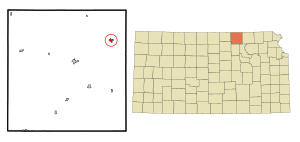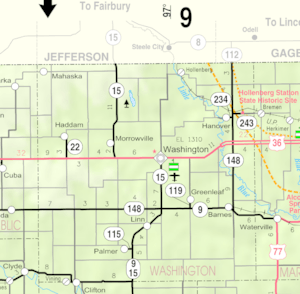Hanover, Kansas facts for kids
Quick facts for kids
Hanover, Kansas
|
|
|---|---|

Location within Washington County and Kansas
|
|

|
|
| Country | United States |
| State | Kansas |
| County | Washington |
| Platted | 1869 |
| Incorporated | 1872 |
| Named for | Hanover, Germany |
| Area | |
| • Total | 0.60 sq mi (1.55 km2) |
| • Land | 0.60 sq mi (1.55 km2) |
| • Water | 0.00 sq mi (0.00 km2) |
| Elevation | 1,280 ft (390 m) |
| Population
(2020)
|
|
| • Total | 690 |
| • Density | 1,150/sq mi (445/km2) |
| Time zone | UTC-6 (CST) |
| • Summer (DST) | UTC-5 (CDT) |
| ZIP code |
66945
|
| Area code | 785 |
| FIPS code | 20-29875 |
| GNIS ID | 2394289 |
Hanover is a small city located in Washington County, Kansas, United States. It's found about 7.5 miles (12 km) south of the border with Nebraska. In 2020, about 690 people lived in Hanover.
Contents
History
Early Days and the Pony Express
Hanover's story began with the "Hollenberg Station." This place became a very important stop for travelers on the Pony Express. Geret Hollenberg started a grocery store and a place for stagecoaches on his farm in 1858.
The Hollenberg farm had nine rooms for people to stay in. Because "Hollenberg Station" was so successful, more people moved to the area. Many settlers came to live near the Hollenbergs before Hanover was officially created.
Before the town was set up, a school district was started in 1868. This was to make sure the children of the new settlers near "Hollenberg Station" could get an education.
German Roots and Growth
Hanover was officially planned out in 1869 and became a city in 1872. It's a German community and was named after Hanover, Germany. The founders, Geret Hollenberg and Sophia Brockmeyer, first settled their farm, which they called "The Cottonwood Ranch." Later, it became the "Hollenberg Station."
This station was a popular stop along the Pony Express route. Its popularity led to the founding of Hanover. The Hollenberg Pony Express Station is the only building left from the original two-thousand-mile Pony Express route. It still stands about one mile northeast of Hanover. In the 1940s, it was recognized as a National Historic Landmark.
Hollenberg, who planned the town in 1869, chose the name Hanover after his hometown in Germany. Someone from that time wrote that Hanover felt like "just a little bit of Germany" in Kansas.
Hanover grew because it was located where two railroads met, making it an important shipping spot. Having access to the railroad helped Hanover's economy a lot. It allowed the local grain elevator to grow and succeed, which in turn helped the town itself grow.
As the town developed, churches were built. A German Evangelical Society church and a Catholic church (for the town's Czech residents) were both started in 1870. Also, after some Native American groups moved to Oklahoma from a nearby reservation, Hanover township gained more land. This allowed the town to expand further as more white settlers arrived.
Native American Neighbors
The area around Hanover was once home to many Native American groups. The Pawnee Indians lived west of Hanover. The Kansa and Kaw tribes lived to the south. The Otoe Indians were located to the north.
The Otoe Reservation was north of Hanover, on the Kansas-Nebraska border, from 1854 to 1883. This reservation was very large, covering 160,000 acres (about 250 square miles). When the Otoe tribal lands were sold in 1883, the land sold for a very high price compared to other Native American lands at that time.
Some of the Otoe Indians moved to Red Rock, Oklahoma. Many Otoe people of mixed heritage joined the local German settlers. Even today, some people in Hanover have a small amount of Native American ancestry.
The region was very appealing to German-speaking settlers. When Hanover was founded, Hollenberg continued to attract settlers from German and Czech backgrounds. Until World War I, many people in Hanover and the surrounding areas still spoke their native languages. Even now, many German traditions are an important part of the town's identity.
German settlers often met Native American groups like the Pawnee, Kansa, and Kaw. Most of the time, these meetings were peaceful, and there were few conflicts. In fact, a lot of trade happened between the settlers and the Native groups.
Where is Hanover?
According to the United States Census Bureau, the city of Hanover covers about 0.54 square miles (1.4 square kilometers) of land. There is no water area within the city limits.
Who Lives in Hanover?
| Historical population | |||
|---|---|---|---|
| Census | Pop. | %± | |
| 1880 | 578 | — | |
| 1890 | 903 | 56.2% | |
| 1900 | 987 | 9.3% | |
| 1910 | 1,039 | 5.3% | |
| 1920 | 947 | −8.9% | |
| 1930 | 880 | −7.1% | |
| 1940 | 896 | 1.8% | |
| 1950 | 854 | −4.7% | |
| 1960 | 773 | −9.5% | |
| 1970 | 793 | 2.6% | |
| 1980 | 802 | 1.1% | |
| 1990 | 696 | −13.2% | |
| 2000 | 653 | −6.2% | |
| 2010 | 682 | 4.4% | |
| 2020 | 690 | 1.2% | |
| U.S. Decennial Census | |||
In 2020, the 2020 United States census counted 690 people living in Hanover. There were 268 households and 158 families. Most people in Hanover are white or European American.
About 26.4% of the people were under 18 years old. The median age in the city was 38.3 years. This means half the people were younger than 38.3, and half were older.
Schools in Hanover
Learning from Preschool to High School
The public schools in Hanover and the nearby rural areas are part of the Barnes–Hanover–Linn USD 223 school district.
Hanover has a few different schools. There's Weecat Preschool, Hanover Public School (which goes from kindergarten to 12th grade), and St. John's Catholic School (for grades 1-8).
Most children in Hanover start their education at the Weecat Preschool. It's located in the basement of St. John’s Catholic School. This preschool was even certified as a nuclear fallout shelter during the Cold War!
After preschool, children go to kindergarten at Hanover Public School. In first grade, students go to different schools based on their family's traditions. Most Lutheran families attend Hanover Public School. Most Catholic families attend St. John’s Catholic School until eighth grade.
Beyond the Classroom
After eighth grade, all students attend Hanover High School. It's a small 1A high school with about 79 students. Many students from Hanover High School compete in national events for the Future Business Leaders of America (FBLA) organization. They also do well at the state level for FBLA and other activities like scholar bowl.
The high school also has strong sports teams in basketball, football, and track. They have won many state championships in the Kansas 1A division 2. Many Hanover students also take college-level courses while still in high school through Cloud County Community College. These are called dual credit courses.
Hanover's Library
Hanover has a small public library. It's located in the basement of the city hall. The library is open for a few hours on Tuesday, Wednesday, Thursday, and Saturday.
Local News
The local newspaper for the Hanover area was called The Hanover News. It reported on current events and was published every week starting in 1877. However, the newspaper stopped publishing in 2019.
See also
 In Spanish: Hanover (Kansas) para niños
In Spanish: Hanover (Kansas) para niños

